Substitute for Broccoli
You'll find several excellent substitutes for broccoli that offer similar nutritional benefits and cooking versatility. Cauliflower stands out as the closest match, providing comparable texture and nutrients while working well in most recipes. Brussels sprouts make an excellent alternative for roasting, while kale offers impressive vitamin content for salads and smoothies. Green cabbage provides a similar crunch but should be used in smaller quantities, and Swiss chard brings sweetness when steamed. Each substitute has unique cooking requirements and storage needs, from temperature adjustments to preparation methods. Understanding these alternatives' specific characteristics will help you create successful, nutrient-rich meals.
This post may contain affiliate links. If you make a purchase through these links, I may earn a commission at no additional cost to you. Additionally, portions of this post may be generated using artificial intelligence (AI) technology. While we strive for accuracy, please be aware that AI-generated content may not always be perfect and should be fact-checked when necessary.
The Spatula Scoops
- Cauliflower is the closest substitute for broccoli, offering similar texture and cooking versatility with comparable nutritional benefits.
- Brussels sprouts work excellently as a broccoli replacement, particularly in roasted dishes, providing similar health benefits and glucosinolates.
- Kale serves as a nutrient-rich alternative, packed with vitamins A, C, and K, perfect for salads and smoothies.
- Green cabbage offers a similar crunch and mild taste, ideal for stir-fries, but should be used in half the quantity.
- Swiss chard provides comparable vitamins and works well both raw and cooked, developing a pleasant sweetness when steamed.
What Makes Broccoli Special
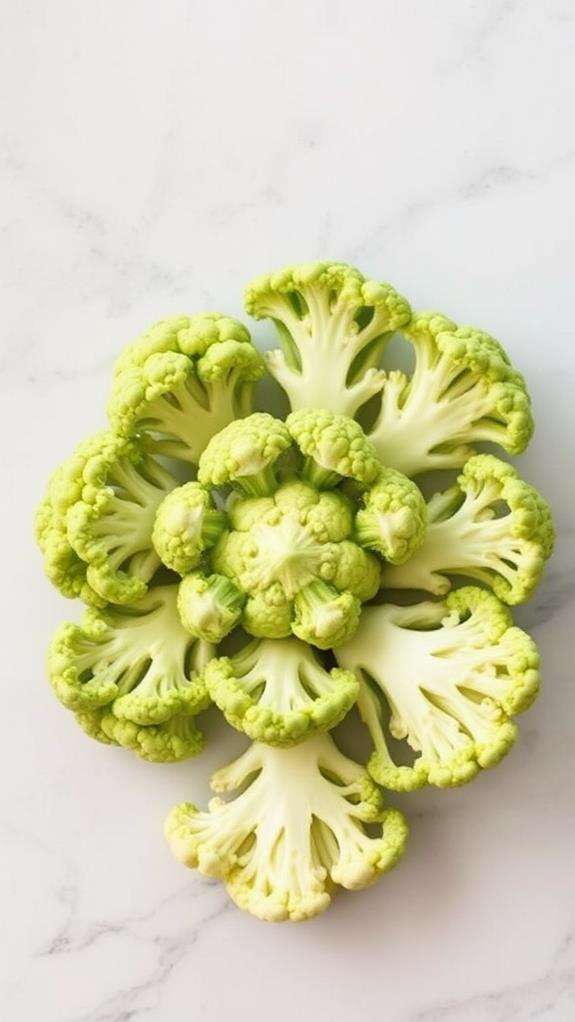
Along with its distinctive tree-like appearance, broccoli stands out as a nutritional powerhouse. This green cruciferous vegetable packs an impressive array of vitamins and minerals into its compact florets, making it one of the most nutrient-dense options you'll find in the produce aisle. When you're looking to boost your daily intake of vitamins K and C, you'll find that broccoli delivers these essential nutrients in abundance, along with a healthy dose of fiber and antioxidants. Additionally, incorporating it into your meal prep can be made even easier with leak-proof storage options like the Ello Duraglass Meal Prep Containers, which help maintain the freshness of your veggies.
You'll notice that broccoli's flavor profile changes throughout the growing season, becoming significantly sweeter during colder months. This culinary versatility makes it an excellent addition to your meal planning, as you can adapt its preparation methods to suit different dishes. Whether you're steaming, roasting, or transforming it into broccoli rice, this leafy green demonstrates remarkable adaptability in the kitchen. The health benefits you'll gain from incorporating broccoli into your diet are substantial, and its storage flexibility means you can keep it fresh in your refrigerator for up to a week, or even two weeks if you've chosen organic varieties.
Best Broccoli Alternatives
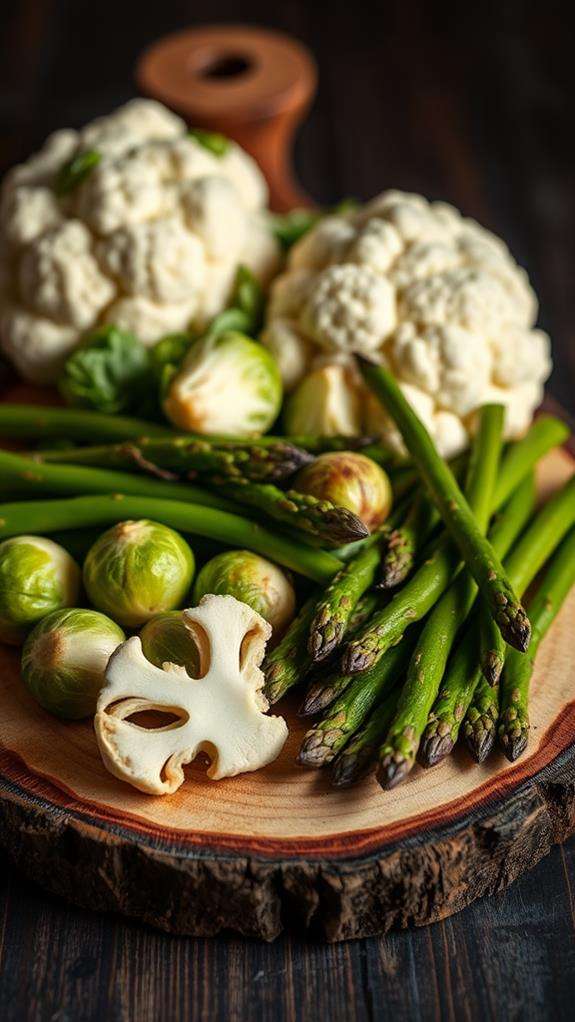
When you're looking to replace broccoli in your recipes, you'll find several nutrient-rich vegetables that can step in admirably, with cauliflower leading the pack as the closest match in both texture and cooking versatility. Your choice of substitute might depend on your cooking method, as options like Brussels sprouts excel in roasting while Swiss chard shines in quick sautés or fresh preparations. For the most successful substitution, consider both the cooking technique and the final dish's intended flavor profile, keeping in mind that vegetables like kale may require adjusted cooking times while green cabbage can offer a similar crunch with a milder taste.
Top Broccoli Replacement Options
Several excellent alternatives can replace broccoli in your favorite recipes while maintaining nutritional value and complementary flavors. You'll find cauliflower to be your closest match, offering similar texture and versatility whether you're steaming, roasting, or pureeing. When you're looking for a nutrient-dense substitute, Brussels sprouts provide comparable health benefits and excel particularly well in roasted dishes.
| Vegetable | Best Used In | Cooking Method | Substitution Ratio |
|---|---|---|---|
| Cauliflower | Casseroles, Stir-fries | Steam, Roast | 1:1 |
| Brussels Sprouts | Side Dishes, Roasts | Roast, Sauté | 1:1 |
| Kale | Salads, Smoothies | Raw, Steam | 2:1 |
| Green Cabbage | Stir-fries, Slaws | Sauté, Raw | 1/2:1 |
For a leafy alternative, you'll want to take into account kale or Swiss chard, both packed with vitamins A, C, and K. These vegetables work wonderfully in both raw and cooked applications. If you're preparing a stir-fry, green cabbage offers a satisfying crunch and similar fiber content – just remember to use half the amount of shredded cabbage compared to broccoli florets.
Cooking With Broccoli Substitutes
Making the most of broccoli substitutes requires understanding their unique cooking characteristics and ideal preparation methods. When you're working with cauliflower, a good substitute for broccoli, you'll find it shares a similar texture and can be prepared using identical cooking times. You can steam, roast, or puree it just as you would broccoli.
If you're using leafy green vegetables like kale or swiss chard, you'll need to adjust your cooking approach. Kale typically requires longer cooking times to become tender, while swiss chard cooks more quickly and works well when you sauté the stems and smaller leaves separately. When incorporating green cabbage into your recipes, remember to use half the amount called for in your broccoli recipe, as it's more compact.
For best results with Brussels sprouts, focus on dry-heat cooking methods like roasting or sautéing to bring out their natural sweetness. You'll want to avoid using them in soups where their strong flavor might overwhelm the dish. When preparing these substitutes, always consider their individual cooking times and moisture content to achieve the best results in your recipes.
Cooking With Broccoli Substitutes
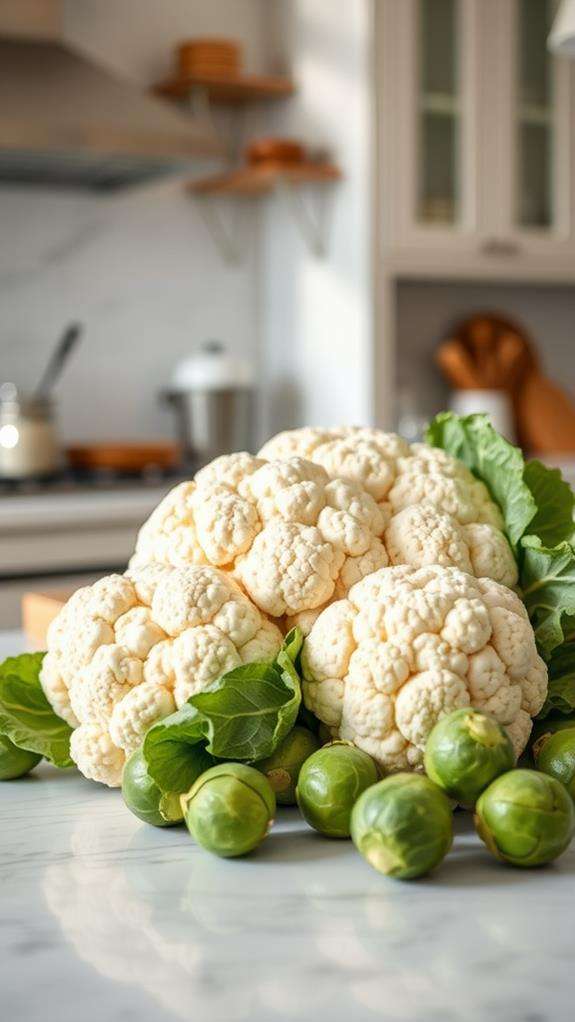
When you're cooking with broccoli substitutes, you'll find that each vegetable requires specific temperature adjustments, with cauliflower needing about 425°F for ideal roasting and Brussels sprouts performing best at 400°F for achieving crispy edges. You can adapt your cooking methods by steaming tender vegetables like broccolini for 3-4 minutes or boiling heartier alternatives like Swiss chard stems for 5-7 minutes, adjusting the timing based on the vegetable's density. For raw preparations, you'll want to slice kale into thin ribbons, removing tough stems first, while cauliflower can be grated into rice-sized pieces or chopped into small florets that mimic broccoli's familiar shape.
Best Roasting Temperature Methods
The perfect roasting temperature can transform broccoli substitutes from ordinary vegetables into caramelized, flavorful delights. For best results, you'll want to set your oven to 220°C (420°F), which is the ideal temperature for achieving that coveted golden-brown exterior while maintaining tenderness inside. Before roasting, toss your vegetables in olive oil and season them thoroughly to enhance their natural flavors during cooking.
When you're working with denser substitutes like cauliflower or Brussels sprouts, you'll need to adjust your cooking time to 25-30 minutes for complete tenderness. To achieve the best caramelization, make sure you're spreading your vegetables in a single layer on the baking sheet, particularly when roasting leafy alternatives like kale or Swiss chard. This spacing prevents unwanted steaming and promotes even cooking throughout.
You'll know your vegetables are perfectly roasted when they're fork-tender and display attractive charred spots on the exterior. Keep an eye on them during the final minutes of cooking, as these indicators of caramelization will tell you when they've reached their peak flavor and texture.
Steam Versus Boil Alternatives
Since proper cooking methods can make or break your dish, understanding whether to steam or boil broccoli substitutes is essential for achieving the best results.
When you're working with broccoli alternatives, steaming consistently outperforms boiling across various vegetables. You'll find that cauliflower maintains its desirable firm texture through steaming for 5-7 minutes, while boiling often results in an unappetizing mushiness. Brussels sprouts, another excellent substitute, retain their nutrients and natural flavor through steaming, helping you avoid the sulfurous smell that boiling typically produces.
For leafy alternatives like kale and Swiss chard, steaming proves particularly effective. You'll want to steam kale for just 3-5 minutes to preserve its nutritional value while softening its tough texture. Swiss chard responds exceptionally well to steaming, developing a subtle sweetness that boiling might diminish. The cooking time for these vegetables is significantly shorter when steaming, which helps maintain their vibrant colors and essential nutrients. By choosing to steam rather than boil your broccoli substitutes, you'll consistently achieve better flavor, texture, and nutritional outcomes in your dishes.
Raw Substitute Preparation Tips
Moving beyond cooking methods, raw preparation techniques for broccoli substitutes offer fresh, crisp alternatives that preserve maximum nutrients and natural flavors. When you're at the grocery store looking for raw broccoli substitutes, you'll find several leafy greens and cruciferous vegetables that can provide similar taste and texture profiles.
To prepare your raw substitutes effectively, consider these essential techniques:
- Grate cauliflower florets using a box grater or food processor to achieve a texture that's remarkably similar to chopped raw broccoli, perfect for salads and dips
- Slice Brussels sprouts thinly with a mandoline or sharp knife, creating delicate shavings that offer an excellent crunch and nutty flavor
- Massage kale leaves with a pinch of salt for 2-3 minutes until they become tender and more palatable as a raw substitute
You can also incorporate raw broccolini by cutting it into bite-sized pieces, focusing on the tender stems and small florets. If you're seeking a milder option, raw spinach provides an excellent substitute that doesn't require any special preparation beyond a quick rinse and dry.
Nutritional Value Comparison
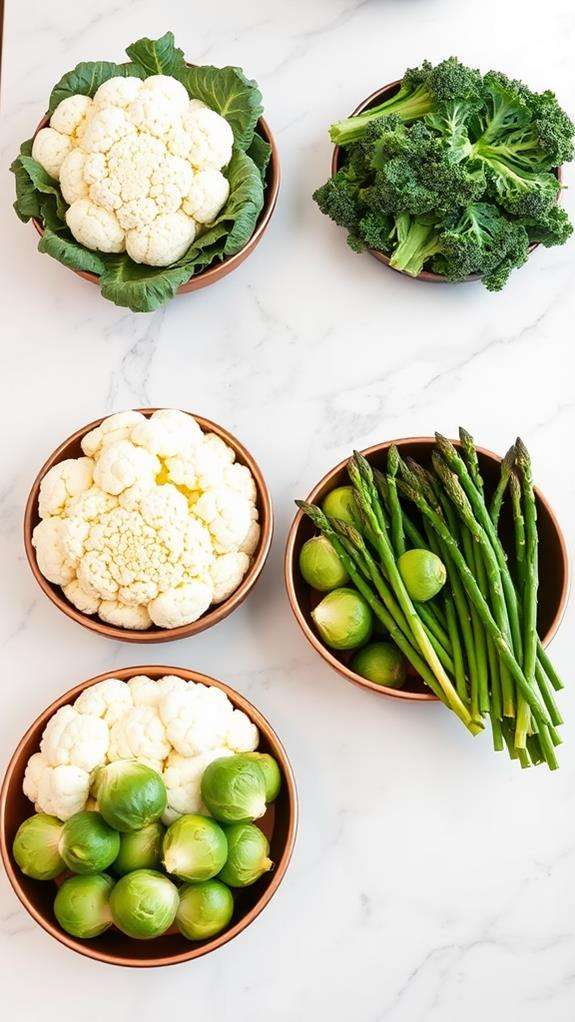
Understanding broccoli's nutritional profile helps you choose the right substitute for your dietary needs. When you're looking to replace broccoli, you'll want to take into account how each alternative measures up regarding essential nutrients and health benefits.
Cauliflower comes closest to matching broccoli's overall profile, though you'll get less fiber and protein. If you're focused on maximizing your vitamin intake, kale serves as an excellent substitute, delivering impressive amounts of vitamins A, C, and K, plus beneficial antioxidants. Brussels sprouts offer a comparable nutritional package, and they'll give you an added bonus of unique glucosinolates that support your health.
For a milder flavor while maintaining strong nutritional value, you'll find Swiss chard to be a worthy alternative. It provides similar levels of vitamins A, C, and K to broccoli, though in different proportions. When comparing these substitutes, remember that broccoli sets a high bar with over 100% of your daily vitamin K needs and more than 150% of vitamin C per cup. Each alternative brings its own nutritional strengths, so you can select based on your specific dietary requirements.
Storage Tips for Substitutes
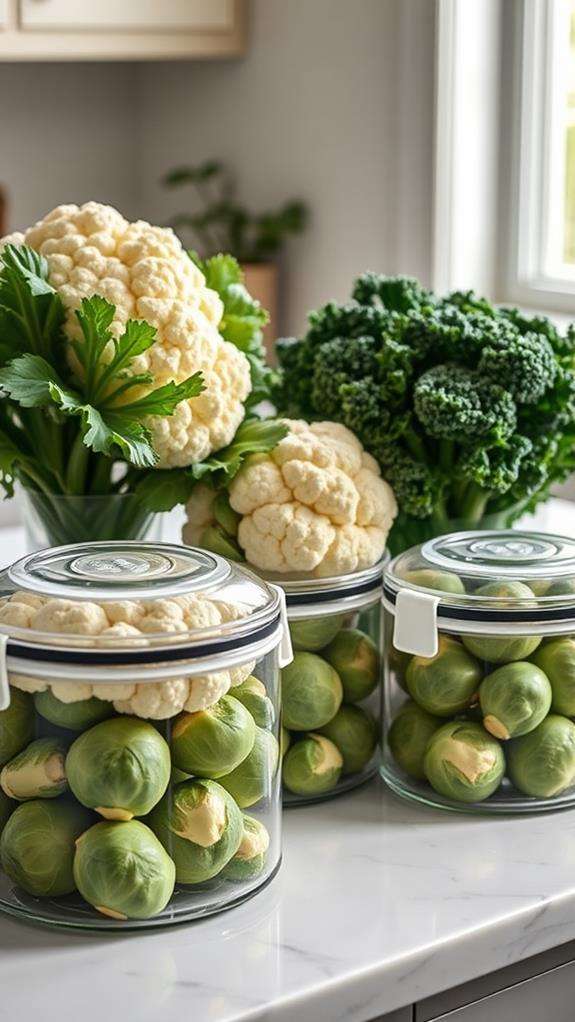
Proper storage of your broccoli substitutes makes all the difference in maintaining their freshness and nutritional value. When you're working with leafy greens and various alternatives, following specific storage tips will help maximize their shelf life and keep nutrients intact. For the best results, store your substitutes in the refrigerator using plastic bags, ensuring they remain crisp and ready for use. Additionally, be mindful of temperature control as it can greatly impact the longevity of your greens; for instance, keeping them at or below 40F can prevent spoilage fresh crab storage durations.
Here are essential storage guidelines to prevent premature wilting:
- Keep leafy greens like spinach and Swiss chard unwashed and dry until you're ready to use them, as excess moisture can speed up deterioration.
- Place broccoli rabe and similar vegetables in a cool, dark place, checking regularly for any yellowing or signs of spoilage.
- Store whole cabbage and larger substitutes intact, since cutting them will reduce their shelf life greatly.
When handling more delicate substitutes like broccolini, you'll want to use them within a few days of purchase for ideal nutrient retention. For vegetables like Brussels sprouts, proper storage in the refrigerator can maintain freshness for about a week, giving you plenty of time to incorporate them into your meals.
Seasonal Availability Guide
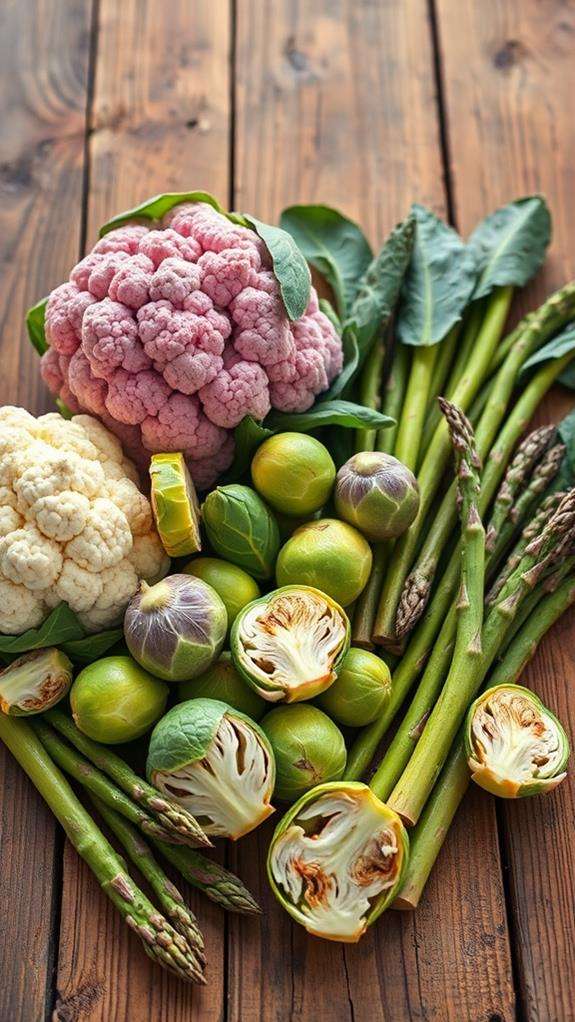
Seasonal awareness plays an essential role when selecting broccoli substitutes for your cooking needs. While broccoli itself is available year-round at your local farmers market, you'll want to take into account the seasonal patterns of potential green substitutes to guarantee you're getting the freshest options with ideal nutritional value.
When you're choosing a seasonal substitute for broccoli, remember that organic alternatives often provide extended shelf life and better flavor profiles. You'll find that many green vegetables follow similar growing patterns to broccoli, becoming sweeter during winter months due to colder temperatures. To maximize your options, you'll want to check local growing schedules and availability patterns throughout the year. During broccoli's peak season, which varies by region, you might find that similar cruciferous vegetables are also at their prime. Think about tracking the seasonal cycles of potential substitutes at your local farmers market, where vendors can provide detailed information about growing conditions and peak harvesting times. This knowledge will help you make informed decisions about which alternatives will best match broccoli's texture and flavor profile during different times of the year.
Recipe Adaptations

Adapting recipes that call for broccoli requires careful thought of both cooking methods and flavor profiles. When you're looking for a good substitute, cauliflower stands out as a great alternative since it shares similar taste and texture characteristics with regular broccoli. You'll find that baby broccoli, also known as broccolini, works exceptionally well in dishes where you'd typically use broccoli florets.
Here are key adaptations to ponder when substituting:
- Replace broccoli with leafy greens like kale or Swiss chard in sautéed dishes, but reduce cooking time by 2-3 minutes
- Swap cauliflower for broccoli in roasted dishes, maintaining the same temperature and cooking duration
- Use Brussels sprouts as an alternative in stir-fries, but avoid them in soups where they might create unwanted flavor notes
When working with these substitutes, you'll want to adjust seasoning levels accordingly. For instance, if you're using cauliflower, you might need to increase herbs and spices slightly since it has a milder flavor than broccoli. Remember that leafy greens will cook down considerably more than regular broccoli, so you'll need to start with a larger quantity.
Expert Recommendations

Leading nutrition and culinary experts consistently recommend cauliflower as the top broccoli substitute, particularly in roasted dishes and stir-fries. You'll find it's an excellent substitute that won't trigger health problems for those sensitive to broccoli's bitter compounds, especially when sautéed with garlic and olive oil.
For those seeking alternatives packed with antioxidants, experts suggest kale as your go-to green leafy vegetable. It's particularly versatile and makes a great side when you're looking to maintain nutritional value without compromising taste. If you're concerned about getting enough vitamins, broccolini offers a good broccoli alternative that's slightly sweeter and more tender than its cousin. Nutrition specialists often point to Brussels sprouts as another robust option, though you'll want to roast them properly to minimize their strong flavor. When working with Swiss chard, you'll find it's especially effective in dishes where you'd typically use broccoli florets, as it provides similar nutritional benefits while offering a milder taste profile. Remember to adjust cooking times accordingly, as these substitutes may require different preparation methods to achieve ideal results.
Frequently Asked Questions
What Vegetable Is Equal to Broccoli?
You'll find cauliflower is the closest match to broccoli, sharing similar texture and nutritional benefits. It's your best bet when you need a direct replacement in recipes. If you're looking for alternatives, broccolini offers a sweeter taste with tender stems, while kale provides comparable nutrients but with a different texture. Brussels sprouts and green cabbage can work too, though they'll bring their own distinct flavors to your dishes.
What Is the Green Vegetable Like Broccoli?
If you're looking for a green vegetable that's most similar to broccoli, cauliflower is your best match, despite its white color. They share comparable textures and shapes, though cauliflower offers a milder taste. You'll also find broccolini, a hybrid variety, provides a similar experience with its small florets and tender stems. Brussels sprouts and kale, while part of the same vegetable family, offer different textures but comparable nutritional benefits.
What Can You Substitute for Broccoli on the Military Diet?
Like soldiers swapping posts on guard duty, you've got several reliable substitutes for broccoli on the Military Diet. You'll find cauliflower's the closest match, offering similar texture with fewer calories. For variety, you can opt for nutrient-rich kale, versatile green beans, fiber-packed Brussels sprouts, or vitamin-loaded spinach. Each of these alternatives maintains the diet's strict nutritional guidelines while providing essential vitamins and minerals you'd expect from broccoli.
What Other Vegetables Are Broccoli?
You'll find several vegetables that belong to the same family as broccoli, known as cruciferous vegetables. These include broccoli rabe, which has a more bitter taste, and Chinese broccoli (gai lan) with its flat leaves and small florets. There's also broccolini, a hybrid variety with longer stems and smaller florets. While not exactly the same, cauliflower and kale are close relatives that share similar nutritional benefits within the Brassica family.





